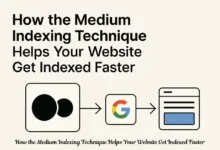How Google Discover Chooses Winners: The Real Rules Behind Trend Exposure

How Google Discover Chooses Winners is explained in 2025’s latest algorithm update — uncover how Google’s AI decides which articles gain trend exposure and go viral.
table of contents
How Google Discover Chooses Winners: Understanding the Algorithm Behind Trend Exposure
Google Discover has evolved into one of the most influential sources of traffic on the internet. It no longer just recommends articles — it selects winners.
In 2025, Discover’s system operates through an intricate blend of AI ranking models, real-time engagement tracking, and visual content analysis to determine which posts deserve viral visibility.
For creators, publishers, and news outlets, understanding how Google Discover makes these choices is essential for mastering trend exposure.
Read : Why Google Indexing Speed Determines Your Trend Traffic in 2025
1. The Evolution of Google Discover (2018–2025)
When Google Discover first appeared in 2018, it functioned like a personalized news feed. But by 2025, it has become a predictive AI platform that determines not only what people want to read — but what they are about to search for.
Timeline of transformation:
- 2018–2020: Basic personalization using user history.
- 2021–2023: Added engagement and freshness ranking signals.
- 2024–2025: Fully integrated machine learning models analyzing user behavior, author trust, and trend patterns.
Discover now serves as a real-time trend detector that constantly filters millions of pages for the next viral piece.
2. How Google Chooses “Winners”
Google Discover’s ranking isn’t random — it’s calculated.
Here’s how the system decides which articles earn that coveted Discover placement:
🟩 1. Freshness Meets Speed
Articles published within the trend window have the highest chance of selection.
A post that appears 10 minutes after a topic starts trending has a dramatically higher chance than one posted hours later.
Timing has officially become an SEO signal.
🟩 2. User Interest Match
Google’s AI matches new content with the “interest clusters” of users.
If your website consistently covers one niche — like AI, technology, or politics — it’s rewarded with priority visibility among similar audiences.
Consistency builds topic authority, and topic authority builds Discover exposure.
🟩 3. Early Engagement
The algorithm monitors user actions within minutes:
- Click-through rate (CTR)
- Dwell time
- Scroll depth
- Interaction (shares, saves, and likes)
If your article achieves above-average engagement early, it’s tagged as “high-potential” and shown to a broader audience.
🟩 4. Visual Relevance
Discover is visual-first.
Use custom high-quality images (at least 1200px width) that clearly reflect your topic.
Google’s visual AI scans every image for thematic accuracy — generic stock photos simply fail in 2025.
🟩 5. E-A-T: Expertise, Authority, Trustworthiness
Discover prefers verified and reliable sources.
Author bios, consistent publication frequency, and transparent editorial standards all increase trust ranking.
Inconsistent, AI-rewritten, or anonymous posts lose visibility almost immediately.
3. The Real Rules Behind Trend Exposure
The core truth about Discover is that it rewards momentum, not just quality.
Once an article is indexed, the first two hours determine its fate.
If it gains clicks, reads, and saves fast enough, Discover’s system expands its reach to new audiences.
If it doesn’t, the algorithm quietly phases it out.
That’s why timing, indexing, and user curiosity are now equal pillars of modern SEO.
In 2025, the strongest metric in Google Discover is speed of engagement.
4. Common Mistakes That Kill Discover Visibility
Even professional publishers often miss the small details that stop their articles from ever reaching Discover feeds:
- Changing headlines after publishing (resets engagement data).
- Using small or irrelevant images (fails visual checks).
- Publishing too late in the trend cycle.
- Keyword stuffing (Discover prefers natural, human phrasing).
- Weak internal linking (Googlebot can’t find the page fast enough).
Discover doesn’t like confusion — it rewards clarity, consistency, and originality.
5. How to Optimize for Discover in 2025
✅ Before Publishing
- Identify emerging topics using Google Trends or Twitter (X).
- Write headlines that combine clarity with curiosity.
- Use structured data like
NewsArticleandImageObject.
✅ After Publishing
- Request indexing in Google Search Console immediately.
- Share across social media to build early click signals.
- Embed links from your homepage or sidebar for fast crawling.
✅ Long-Term Strategy
- Publish consistently on your core niche.
- Build a verified author profile.
- Use vibrant, topic-relevant images in all posts.
- Track Discover data in Search Console to learn what works.
6. Case Study: The Fast Indexing Advantage
Two tech blogs post about “AI-Powered Search Updates” at different times.
| Factor | Site A | Site B |
|---|---|---|
| Publishing Time | 08:45 AM | 12:15 PM |
| Indexing Speed | 15 min | 3 hours |
| CTR (First 6h) | 3.4% | 0.9% |
| Discover Exposure | ✅ Featured | ❌ Ignored |
| 24h Traffic | 7,800 | 430 |
Both used SEO best practices — but Site A won because it aligned with Discover’s “freshness + engagement” model.
7. The Future of Trend Exposure
Google Discover and SGE (Search Generative Experience) are merging into one continuous system.
That means:
- Articles will be surfaced dynamically as events happen.
- Google’s AI will highlight the first verified sources.
- Trend exposure will favor fast, reliable, and human-written content.
Speed and trust are no longer separate metrics — they’re the foundation of visibility.
In 2025, Google Discover doesn’t reward who writes the most — it rewards who connects fastest.
Understanding how Google Discover chooses winners gives you the strategic edge to dominate trend visibility.
Publish fast, stay authentic, use strong visuals —
and let Discover’s algorithm do the rest.
Because in the modern web, speed is credibility.
FAQ
Q1: Can new sites appear on Google Discover?
Yes — if they post original, timely content with strong visuals and topic consistency.
Q2: How fast should I publish after a trending event?
Within the first 30 minutes is ideal to match Discover’s freshness algorithm.
Q3: Do backlinks matter for Discover?
Not much. Engagement and content trust have replaced backlinks in Discover ranking.
Q4: Is Google Discover related to SEO ranking?
Indirectly yes. While Discover isn’t “ranked,” engagement and indexing affect your site’s crawl priority.
Q5: What’s the best image format for Discover in 2025?
Use WebP or high-resolution JPG (≥1200px) with visible focus and topic clarity.
Discover more from Feenanoor
Subscribe to get the latest posts sent to your email.









